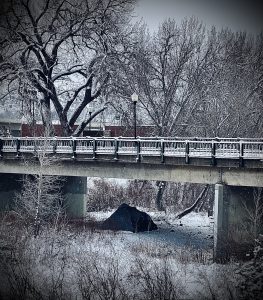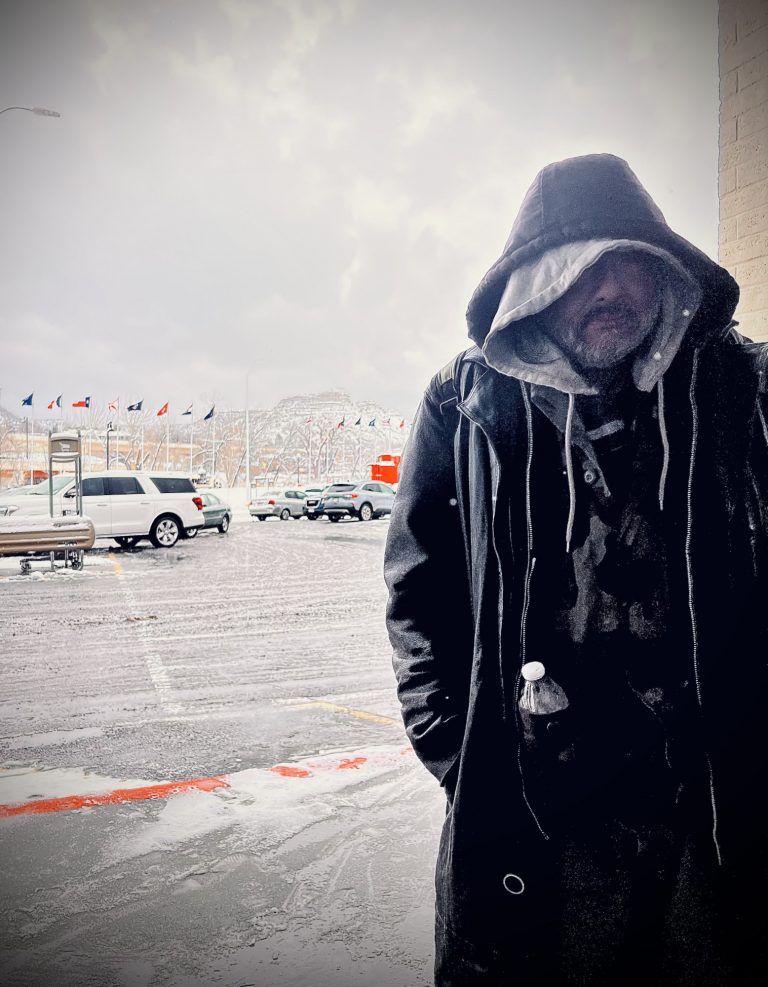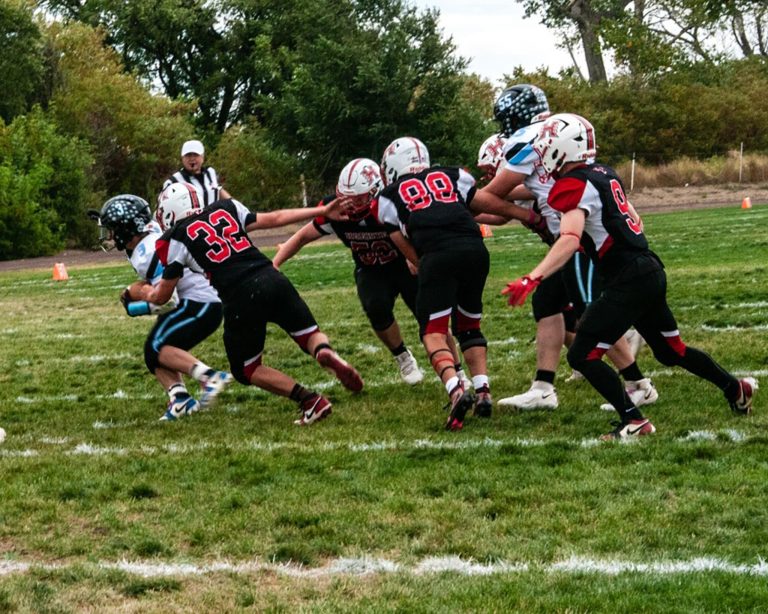T’Naus Nieto
The Chronicle-News
On Jan. 30, as snow fell upon the City of Trinidad and temperatures reached below freezing, Johnathan Grine shuffled along Purgatoire Dr., shivering, hoping someone would spare some change for a warm cup of coffee.
Grine had been homeless for just over two years, but if you met him six years ago, you wouldn’t have recognized him. He owned a home, had a wife and children, investments, a high-paying career and was generally happy. Although he was living his dream, he soon learned that anyone at any time could wake up to a living nightmare.
“I had a way different life 6 years ago,” Grine told The Chronicle-News. “In 2018, I lost my youngest son… Within a year, [my life] just spiraled, and I couldn’t hang (handle it). I don’t know. After losing our kid, me and my wife both just got too depressed, man, and we couldn’t stay together. We ended up losing the house, and I lost my mom right after that. I lost my job — I lost everything. I lived off my investments and 401K for a while (but I) basically couldn’t get out of my depression.”
When asked how his son passed, Grine turned his head and hid his face in his palms, quietly sobbing, before changing the subject.
Grine spoke about drowning his sorrows in substances (not explicitly wanting to state which ones) before finding a job opportunity in Trinidad. He sobered up and traveled south, but the job didn’t pan out, and he ended up living on the city’s streets, without a job, without a home, with no friends or family, often finding himself at the local detox center.
The University of Denver’s assessment of Homelessness in Trinidad, Colorado, claimed that over two-thirds, 66.1%, of Trinidad’s unhoused population reported that they have abused substances such as alcohol or drugs. 56.5% reported they have received mental health treatment.
Studies vary on the state percentages of people who experience homelessness and who also struggle with mental health concerns. One study claimed that 21% of the unhoused had a severe mental health issue, while the Colorado Coalition for the Homeless referenced another study, saying, “71% of people experiencing homelessness had a probable mental illness or major psychiatric distress.”
Founding pastor of The Mission of The Way, a “Church without Walls,” Clay Mason, along with his wife Mary, has spent many years in Trinidad, working seven days a week, caring for the city’s unhoused, including providing church services downtown, food and essential survival items, like propane tanks and heaters for freezing temperatures.
The city doesn’t provide its unhoused population with any shelter from the cold, leaving local churches to fill the void, who often struggle to handle the workload and logistics while maintaining a peaceful environment.
Zion Lutheran Fellowship offered its walls as a warming center for those in need, but after a series of thefts and other damaging instances, it was forced to discontinue in Jan. 2024. After almost exactly a year without a place for people to seek shelter from the cold, the region was hit with an arctic storm, which, according to the National Weather Service Pueblo, brought temperatures far below freezing with windchills of –30 degrees.
The Church of Christ offered its church as a warming center during the storm. But even they got overwhelmed with the stressful situation, citing indoor drug use and turmoil, opting not to open its doors during the snowfall on Jan. 29, 2025, with a promise to continue once they are better prepared.
As he sipped his cup of coffee, Grine said, “I wish there was someplace to warm up. It’s freezing out here.” He also recounted a time he was hospitalized with hypothermia.
Of course, as temperatures can reach freezing in Colorado areas like in Trinidad and people without homes have no place to seek shelter and warmth, they face risks of frostbite, hypothermia and even death.
The National Alliance to End Homelessness claimed that the average life expectancy of a homeless person is about 20 years less than the average life expectancy of people with homes — only around 50 years old.
“I buried too many of them because of fentanyl overdoses, suicide, I buried some because of AIDS,” Mason said. “Sometimes it’s more than my heart can take. But we keep doing it because if it’s not us, then who? I know that if it were me, I’d want somebody to help me too.”
Systems coordinator for the Trinidad and Huerfano County Coalition for the Unhoused, Chelsea Meece, said, “We need to build a strategy, or a system, which will be a coordinated entry system that’s so well designed that if anybody is experiencing homelessness, they have a place to go and get immediate access to resources that are available.”
Many organizations and advocates seek to help those in need or connect them to resources, but too often, they ignore the causes — addressing symptoms rather than the illness.
Of course, what causes one to be homeless is complex, with data and statistics varying and each person having their own unique story and a wide range of different circumstances. Most credible organizations point to a lack of available housing, employment opportunities, substance abuse, and, most notably, mental health — trauma.
Mason shared a story of a young woman who had been homeless since she was 12 and had suffered severe abuse, struggling to cope with the devastating consequences of an unbearable and unforgettable childhood trauma.
“Every time I think about this, I tear up and cry,” Mason said. “I baptized a young lady who was from the West Coast. When she was eight years old, she had her first dose of heroin. Her mother gave it to her. Her mother had her own heroin addiction and [forced] her to support it. Her dad was a member of the Hells Angels. Her mother gave her that dose of heroin so that she’d be complacent and compliant while her stepdaddy and his biker buddies had their way with this child. Her mother was making money off of it by filming it and selling the VHS. That’s going to screw with your head and your heart. She’d (had) been homeless since she was 12. She’s in a better place now. But when we met her, she was a mess. She’s one of the few success stories that we’ve seen go all the way. But she still carries psychological damage that will never be healed this side of heaven. I’m sorry, but hers is not a unique story at all.”
The Colorado Coalition for the Homeless stated, “In many cases, experiences of homelessness and poor health can be traced back to childhood and adolescence… 53.9% of people experiencing homelessness report four or more [adverse childhood experiences] compared to 3- 5% of the general public. These findings reveal the inextricable nature of the impact of trauma.”
“A vast majority of them come from a dysfunctional family setting — abuse, neglect. Misery breeds more misery. Misery loves company,” Mason said. “Until somebody steps in and says, ‘We’re not going to do this anymore. We’re going to break the cycle,’ then these things continue. So, I made it my life’s work, and my wife has done the same thing, that we’re not going to rest until we’ve solved it here.”
With little to no emotional support from family, friends or community, never healing from the loss of his child, Grine bonded with his two dogs, even referring to them as his kids, holding them close to his heart as his desperately needed emotional support animals.
“They ended up taking both of them (the dogs) from me,” Grine said.
When asked who “they” were, Grine replied. “The shelter, the city, I don’t know. They basically don’t like the homeless to have pets. I went to detox a couple of times, and they took my dog down there (to the shelter). When I went to the hospital for hyperthermia, they took my other dog. They used that as an excuse that I couldn’t take care of them. I had court yesterday for a release hearing for my dog. The judge wouldn’t release him. I told them, ‘These aren’t my pets. These are my kids. You took my kids. These ain’t just my pets they’re my only family.’”
Most recently, the unhoused population spurred controversy when, on Jan. 7, Trinidad State College president Rhonda Epper shocked Trinidad City Council when she said she was accosted just three days prior by what she presumed was an unhoused person wielding an ax.
The suspect who “accosted” the TSC president, Jeremy Ross, was emotional over the loss of his cat, Andromeda, who residents often saw riding on Ross’s shoulder. Even in the back of the police car, officers said Ross was crying and begging them to help find his companion.
The incident was picked up by statewide media, which placed a telescope on Colorado’s southernmost city and its homeless population.
Although the council has spoke many times regarding the homeless downtown, before and since Epper’s anecdote, they’ve recently discussed the possibility of a designated camping area or a centralized fenced-off location for the unhoused, mirroring what the City of Alamosa has enacted. The council even took a trip to the city to survey the area and consider what it could mean for Trinidad.
Yet, a search through Alamosa’s own back-and-forth history with even that idea, shows there is no perfect solution.
According to the Colorado Coalition for the Homeless’s Point in Time Report, there was a 150% increase in chronic homelessness over the past decade, and Colorado had a 31% increase over the previous year, which was the fourth-highest percentage in the United States, trailing only New Hampshire, New Mexico, and New York.
Mason said, “Homelessness and houselessness are not the same thing. Homelessness denotes a detachment from community or family. So that safety net of community and family is gone. It’s non-existent. It’s the number one reason why the homelessness crisis exists in America today—There’s no safety net.”
“Most middle-class people don’t realize that they’re just a paycheck or two away from needing me to bring them a burrito down by the river,” Mason said.





